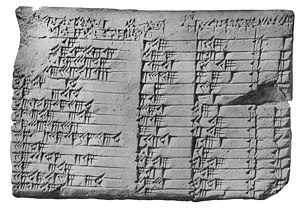Science
Related: About this forumBabylonian trigonometry "simpler, more accurate... has clear advantages over our own."
http://popular-archaeology.com/issue/june-2013/article/a-remarkable-ancient-babylonian-tablet-and-why-it-matters"This means it has great relevance for our modern world. Babylonian mathematics may have been out of fashion for more than 3000 years, but it has possible practical applications in surveying, computer graphics and education.
"This is a rare example of the ancient world teaching us something new," he says.

photo of Plimpton 322
eppur_se_muova
(36,299 posts)None is provided.
Trigonometry is not a science of approximations, but of identities. There can't BE a "more accurate" version.
Wounded Bear
(58,721 posts)eShirl
(18,505 posts)Jim__
(14,083 posts)They give their rationale for the claim toward the end of this short video:
[center]
Binkie The Clown
(7,911 posts)Why do reporters have to sensationalize and exaggerate everything they write for the general public? They could have simply said that the Babylonians took a slightly different approach and arrived at a pretty good approximation for their time. We also use ratios when we teach school children that pi is approximately equal to 22/7. The ratio 355/113 is even better. But neither of them is "more accurate" than the actual irrational (ir-rational) number that is pi.
That they has such an accurate table is newsworthy. The rest is just silliness, (like "maybe space aliens taught it to them"![]() .
.
hunter
(38,328 posts)Last edited Sat Aug 26, 2017, 08:11 PM - Edit history (1)
There are simply no entries for angles that can't be described exactly with known fractions.
To solve problems with angles that are not exact fractions, the user of the table might make a "good enough" interpolation between the known fractions by adding a familiar (to them) sexagesimal fraction, 1/60, 2/60, 3/60.... etc.
The Babylonians handled pi in a similar fashion, using the fraction 25/8 knowing it was a little short but good enough for most work.
For more critical work 25/8 + 1/60 was a pretty good approximation.
25/8 + 1/60 = 3.141666......
muriel_volestrangler
(101,374 posts)This is by the paper's authors:
...
Fundamentally a trigonometric table must describe three ratios of a right triangle. So we throw away sin and cos and instead start with the ratios b/l and d/l. The ratio which replaces tan would then be b/d or d/b, but neither can be expressed exactly in sexagesimal.
Instead, information about this ratio is split into three columns of exact numbers. A squared index and simplified values of b and d to help the scribe make their own approximation to b/d or d/b.
https://theconversation.com/written-in-stone-the-worlds-first-trigonometry-revealed-in-an-ancient-babylonian-tablet-81472

"The first five rows of Plimpton 322, with reconstructed columns and numbers written in decimal."
Now, of course, tan is not "b/d or d/b", since tan does not involve a diagonal. tan is b/l, or l/b (depending on whether you're looking at angles less than or greater than 45 degrees). So these guys are pretty awful at expressing whatever idea they think they have.
But what does "simplified values of b and d" mean? And how were the reconstruction columns and numbers actually written - as the precise fractions - eg for the 5th row (other value of the triplet not shown is 72), so b/l=65/72, d/l=97/72, (d/l) squared=9409/5184? If so, then I suggest a table with its 4th row as 12709/13500, 18541/13500 (or perhaps 1 and 5041/13500), and 343768681/182250000 is not that practical.
Jim__
(14,083 posts)I apologize for the formatting, but I cannot get subscripting to work - most of these n's should be subscripts. The actual text is contained in section: 2. Plimpton 322 of the paper. From the paper:
hunter
(38,328 posts)Converting the table to a decimal format doesn't make things clearer, starting with the first number .99166666 which is 119/120, but probably would have been thought of as the familiar fraction fifty-nine-and-a-half, much as we'd say 59-and-a-half seconds when talking about time. Users of that math would have an intuitive feeling for this fraction.
I tried briefly to use the table in a practical manner, but I'm lazy and not going to learn to sight read (without translation to decimal) sexagesimal numbers, fractions, and all the math shortcuts and abbreviated representations the Babylonians surely used.
I remember as a kid, crazy about computers, how learning to "think in" and do math in binary, octal, or hexadecimal numbers was not a trivial exercise.
FiveGoodMen
(20,018 posts)DetlefK
(16,423 posts)In a fractional number, you give the ratio a:b
I guess, the babylonian trigonometry was based on a system of ratios a:b:c
And, just to be clear on this, our trigonometry is also based on ratios.
Sine and Cosine are both defined as ratios.
The equation sin² + cos² = 1 is exactly the same as the equation a²+b²=c²
NNadir
(33,561 posts)...calculate any value I need for any engineering or scientific task in nanoseconds on a computer.
The statement that the Babylonians had "simpler, more accurate" trigonometry is just silly.